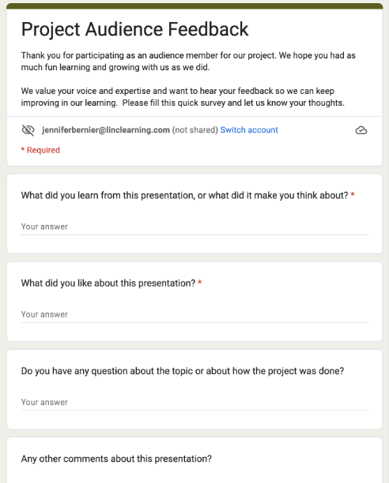How Can I Increase Authenticity in My Lessons?
The days of teachers being the sole audience or receiver of student work are long gone… well at least they should be. Authentic learning goes far beyond the four walls of the classroom and is much more than students receiving a grade from the teacher or demonstrating a skill. Let’s be honest-- that way of learning even sounds BORING! Now is the time to ensure context and meaningful impact for the learning your students engage in.
An Audience For Student Learning Matters
|
FIRST: Start with the essential question. The essential question should be a question that is aligned to the skills/standards that are to be addressed in the unit or lesson. Consider the following when creating the essential question: 💭What are the intended learning outcomes of the task?💭What is the purposeful applications of these skills and knowledge?💭Where would students use these skills or knowledge in an real-world context?💭What problem or issue could be addressed? |
|
DETERMINE AN AUTHENTIC AUDIENCE SECOND: Give students the chance to create for a real audience both locally and globally. 🔑Who are the key stakeholders who would be interested in the problem your students are solving and the product they create? Identify a person or group of people from one of the audiences below:School Community - (ex. Peer reviews, online discussions and class to class presentations) Local Community - (ex. Family members, local business, scientific community, the city council, a government agency, the arts community) Global Community - (ex. Establish relationships with global classes, join a structured global project, reach out to your PLN to support your students, help students publish their work and make it findable by others) Click the links below to explore more awesome ideas for giving students a REAL audience! |
|
LEVERAGE TECHNOLOGY THIRD: Throughout the learning task, use technology to incorporate collaboration, real-world problem solving, community connections, and self-directed learning. 💡 Once you've determined the audience, you'll next think about the purpose of interaction between your students and the selected audience. (i.e. Is it to engage and discuss, demonstrate learning or an exchange of ideas?) 💡 Given the audience and the purpose, what form will your students’ product take? What digital tool could they use in the learning experience? (ex. Published piece: Google Docs, Edublogs, Twitter posts; presentations: Prezi, Google slides, Piktochart, etc.) For additional resources, see the LINC digital toolbox. |
|
CAPTURE FEEDBACK FINALLY, plan for how you will help students capture thoughtful feedback from their audience. Below is an example of how students might capture audience feedback using a Google form. Like this feedback form? Click Here to make a copy!
|
